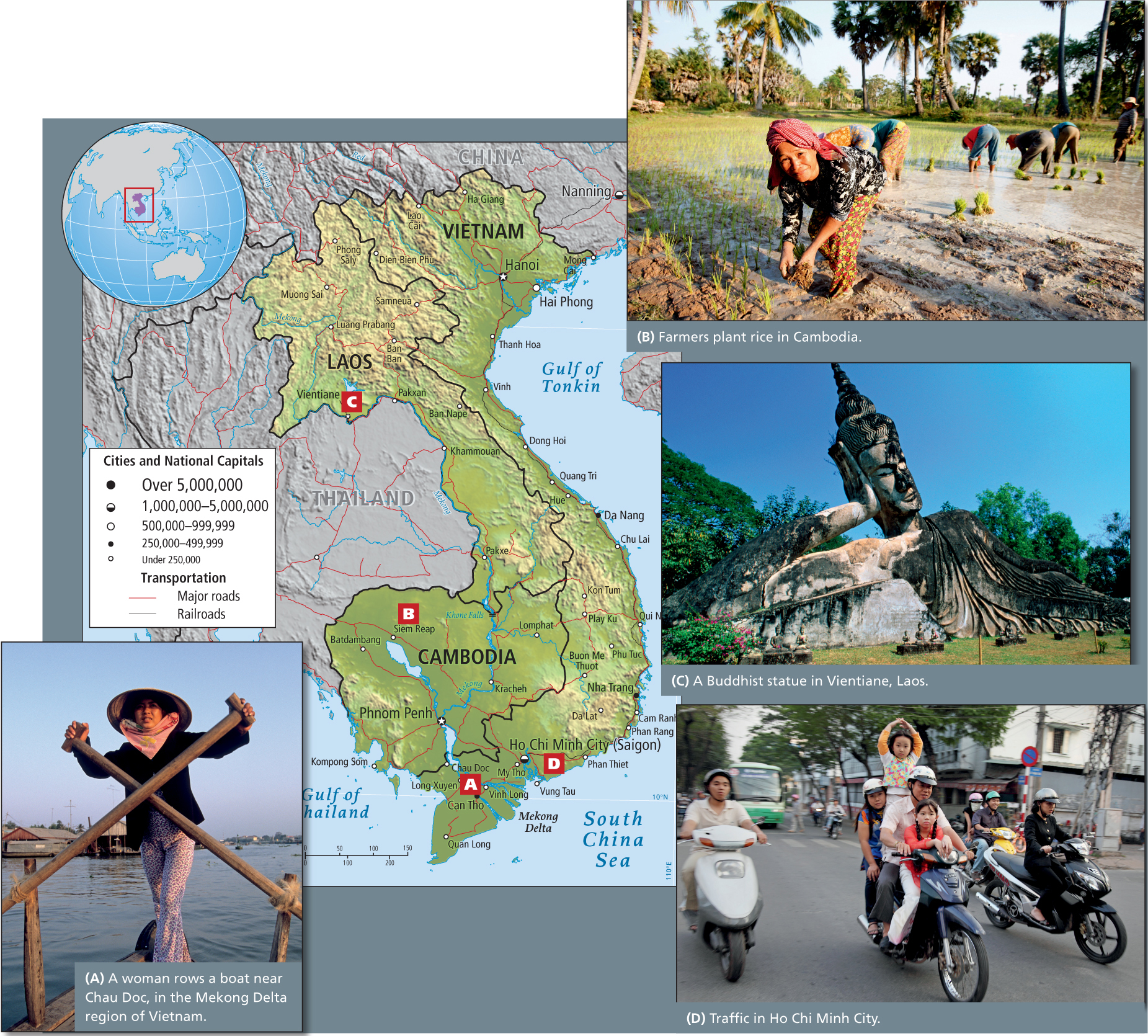Mainland Southeast Asia: Laos, Cambodia, and Vietnam
On the map in Figure 10.31, the countries of Laos, Cambodia, and Vietnam on the Southeast Asian mainland might appear to be ideally suited for peaceful cooperation, sharing as they do a common heritage of Buddhism (see Figure 10.31C) and the Mekong River and its delta. Nonetheless, these three countries went through a disruptive half-century of war that pitted them against each other. Until the end of World War II, all three were colonies, known collectively as French Indochina, and all three fought long struggles to transform themselves into independent nations. And then came the Vietnam War and its aftermath (see the discussion). As of 2013, they remain essentially communist states with measured amounts of free market capitalism. Visitors and investors began arriving in the 1990s, and by 2000, once-somber city streets were abuzz with people and enterprises, especially in Vietnam (see Figure 10.31D).

A long, curved spine of mountains runs through Laos and into Vietnam. In the southern part of the subregion, these mountains are flanked on the west by the broad floodplain of the Mekong that is occupied by Thailand and Cambodia (see the Figure 10.31 map), and on the east by the 1000-mile-long (1600-kilometer-long) coastline and fertile river deltas of Vietnam (see Figure 10.31A). Vietnam, with 87.9 million people, is by far the most populous of these three countries. Cambodia has 14.7 million; Laos, almost entirely mountainous, has only 6.3 million. The rugged mountainous territory of northern Vietnam and Laos is the least densely occupied area in mainland Southeast Asia. Most of the subregion’s population lives along the coastal zones of Vietnam and in the Mekong delta, where people accommodate the seasonal floods by building their homes on stilts, as in the Ganga-Brahmaputra delta in India. Farmers take advantage of the wet tropical climate and flat terrain to cultivate rice (see Figure 10.31B). The Red River delta in northern Vietnam is also an important rice-growing area. Throughout the subregion, at least 75 percent of the people support themselves as subsistence farmers; in Cambodia, only 20 percent of the people live in cities. There, people farm small plots of land as they have for many years. Development experts concerned about sustainable livelihoods for Cambodians say that for the time being this is the wisest way to provide for the population, but to provide truly adequate nutrition and surplus food for cities, managed egalitarian agricultural reform is needed.
The main trading partners for Laos and Cambodia are Thailand and China (as sources of imports) and the United States and Thailand (as destinations for exports of timber, vegetables, and inexpensive manufactured goods). Thai investors wield considerable power in all of these countries because they have broad interests in the production of rice, vegetables, coffee, sugarcane, and cotton for export, in addition to such resources as timber, gypsum, tin, gold, gemstones, and hydroelectric power. A rising environmental issue is the planned damming of the highly biodiverse Mekong River in northern Laos to create hydropower that will be sold primarily to Thailand, which is building the dam. Protests from downstream Cambodia and Vietnam that the environmental impact will be overwhelming have so far been met with silence from Laos, which needs the money.
Vietnam is the most developed of the eastern Southeast Asian mainland countries (see Figure 10.31D). After the United States withdrew its military forces in 1973, the Communist government, assisted by the Soviet Union, began to invest aggressively in health care, basic nutrition, and basic education. By 2012, eighty-seven percent of children reached the fifth grade, and adult literacy was above 94 percent. Forty-eight percent of the Vietnamese people are still cultivators (down from 56 percent just 7 years ago), and they have extensive knowledge of such practical matters as useful plants (including medicinal herbs) and animals, home building and maintenance, and fishing. The Vietnamese have also developed a national flair for excellent cuisine; when times are good, the dinner table is filled with artfully prepared fish, vegetables, herbs, rice, and fruits.
doi moi a program of economic and bureaucratic restructuring in Vietnam, very similar to perestroika in the Soviet Union and the structural adjustment programs imposed on many countries by international lending agencies
The factors that brought growth during the 1990s and 2000s also caused considerable dislocation in some parts of society. One focus of doi moi has been the privatization of land and other publicly held assets. The farmers who own newly privatized land have more security and so pay more attention to conservation and efficient production. But land reform left out the poorest people, who have had to resort to the informal economy to make a living. And in the late 1990s, farmers felt the squeeze when some of their lands were confiscated for use in foreign-funded enterprises such as tourist hotels, golf courses, and oil refineries.
THINGS TO REMEMBER
 Laos, Cambodia, and Vietnam share the Mekong River and its delta on the Southeast Asian mainland; contentions about how to use this river sustainably are rising.
Laos, Cambodia, and Vietnam share the Mekong River and its delta on the Southeast Asian mainland; contentions about how to use this river sustainably are rising. Laos and Cambodia are the poorest countries in the subregion and are still struggling after years of warfare associated with the Vietnam War.
Laos and Cambodia are the poorest countries in the subregion and are still struggling after years of warfare associated with the Vietnam War. Of the three countries in this subregion, Vietnam has the highest human well-being ranking, the largest population, and the largest economy.
Of the three countries in this subregion, Vietnam has the highest human well-being ranking, the largest population, and the largest economy.